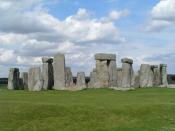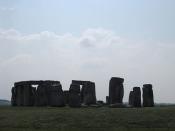There There are four basic levels of social complexity that have been proposed by archaeologists. The band, with less than 100 individuals, egalitarian, mobile hunter-gatherers whose architecture consists of primarily temporary shelters. Tribes with up to 1000 people, segmentary society, permanent villages and permanent structural forms. Chiefdoms with 5,000 to 20,000 people, stratified societies, craft specialization, large scale food production and large-scale monument construction. Finally state societies with populations over 20,000 people, class based hierarchy, highly stratified sociopolitical integration and large scale temples and monuments.
Since the construction of Stonehenge is proposed to have taken over 800 years to complete, it would be safe to assume that the society that began its construction was a tribe, then over time developed into a complex chiefdom.
If Stonehenge was built for the purpose of predicting astronomical events, its primary purpose for doing so would be correlated specifically with agricultural applications. By being able to predict seasonal changes, farmers would know the best times for planting crops, harvest and fertilize (if any).
As a result, farmers that had access to this type of knowledge would ultimately have higher yielding crops, resulting in food surplus that would lead to population growth.
The first phase of construction could have been completed by a tribe. The oldest stone in Stonehenge is the "Heel"ÃÂ stone. After placement of the Heel stone the "ditch and bank"ÃÂ fortification was probably raised. Finally, religious leaders started recording lunar eclipses by creating the Aubrey holes.
The second phase of construction involving the placement of the Blue Stone Circle does not occur until approximately 700 years after the initial phase of construction. This is plenty of time for a tribal society to grow in population, amass food surplus and develop craft specialization.
Because the second phase involves the movement of a...


